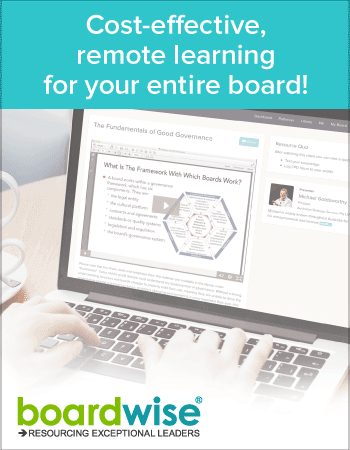Company Secretary Playbook: How to Reduce the Size of Board Packs
-
governance
Governance Company Secretary Playbook: How to Reduce the Size of Board Packs
Board papers, also known as board packs, are the essential materials provided to board directors to prepare them for productive board meetings. These packs typically contain important documents, reports, and reference materials that the board needs to be informed on to make effective decisions during the meeting.
However, many not-for-profit boards struggle with board packs becoming overly large and unwieldy, leading to counterproductive meetings.
According to a 2017 study by ICSA (now the The Chartered Governance Institute UK & Ireland), nearly three-quarters of survey respondents (74%) believed their board packs were too long.
The study found that the average pack length correlates with organisation size, ranging from 125 pages for organisations with under £10 million turnover, to over 250 pages for those above £500 million in turnover. The research shows board packs are typically longer at public companies and in the public sector.
However these figures disguise considerable variation. 20% of respondents report board packs longer than 250 pages, with 1% exceeding 800 pages.
Annually, large organisations produce around 2,000 pages of board information, and much more for organisations with multiple board committees. Even the smallest groups consistently produce ~750 pages yearly.
A 300-page board pack is common at complex organisations. But in reality, only a fraction of those pages end up being relevant to actual board discussions and decisions. The rest is superfluous content that overburdens directors.
This problem can be even more pronounced at resource-constrained not-for-profit organisations who have volunteer directors with limited time.
When board packs become bloated, the following negative consequences result:
- Directors feel overwhelmed preparing and fail to fully read the content
- Critical information gets buried
- Meetings become less productive due to lack of understanding
- The director’s role seems onerous due to workload
- Strategic oversight and governance suffers
- Strategic discussions and subsequent decisions may be sub-optimal
Missed information can also create liability risks. Plus, overly lengthy packs waste significant effort for minimal benefit.
Fortunately, with some concerted effort, organisations can optimise their board information flow to create concise, effective board packs.
Below we outline twelve strategies to reduce board pack length, improve quality, and increase the effectiveness of the board.
1. Get Board Buy-In
Attempting to overhaul and streamline packs starts with getting board and chairperson buy-in. Present a proposal to reduce and focus content, explaining the benefits:
- Improved director preparation
- Faster reading time
- Ability to absorb important information more effectively
- More time for strategic discussions
- Reduced workload frustration
- Streamline staff time to prepare board packs
Keep the focus on enabling excellent governance through the use of concise packs. With chairperson and board support, proposed changes will meet less resistance.
Try to ensure the majority of the board and executive agree that shorter packs will foster better informed and more engaged directors.
2. Perform a Content Audit
Thoroughly inventory and audit past board pack content. Use this process to try and answer the following key questions:
- Which materials are indispensable for directors?
- What provides helpful context versus unnecessary detail?
- How much relates to operations vs. strategy?
- Where might content be consolidated?
- What supplementary info could move into reference appendices?
Take notes on the purpose of each component inform the moderation process. Identify lower priority materials for potential removal or appendix inclusion, allowing directors to focus on strategic governance content.
It is worthwhile asking directors specifically what is useful and what is not rather than simply relying on assumptions.
3. Set a Page Count Guideline
After a baseline audit, set an approximate page count target for the optimised pack, such as 100 pages. Or in some situations instead of page count target a reduction of content by percentage (eg: 50%).
The ideal maximum length will vary based on specific organisational needs. But a defined target drives reduction efforts and prevents future bloat.
Remember, no one actually fully digests a 200+ page pack.
Ensure it is clear to all who contribute to a board back that they need to prioritise condensed critical information over total volume.
4. Provide Information via a Board Portal
Rather than overloading the main pack, utilise a board portal to house supplementary documents and archives and link to them.
Products such as the Our Cat Herder Board Portal allow secure 24/7 access to materials like past meeting records, reference guides, and detailed operational updates, as well as allowing easy linkage to reference material in their agenda building tools.
By keeping the core pack lean and shifting non-essential items to links or appendices that are in the board portal, information accessibility is improved without overburdening directors.
5. Remove Operational Details
The pack should contain high-level summaries, not operational minutiae. Consolidate granular reports into a 1-2 page executive or CEO update on key metrics, risks, and performance.
Rather than attaching detailed departmental reports, include only top organisational priorities and decisions for board oversight. If more specifics are needed, provide via board portal access or through follow-up. Only add additional details for the specific issue or topic not to everything.
6. Distribute Updates Between Meetings
Use your board portal’s discussion feature to post project milestones and decision updates between meetings to keep the board informed without weighing down each pack.
Avoid lengthy progress reports on initiatives already in motion.
Additionally consider using circular resolutions (sometimes know as flying minutes) for routine decisions and voting, allowing you to remove uncontroversial and routine decisions from meetings.
7. Link Reports to Strategic Priorities
The CEO’s (or any other executive) report should focus primarily on progress towards long-term organisational strategy and goals in order to steer discussion toward the board’s role in providing strategic guidance.
All other board papers should also directly tie to strategic objectives and key performance indicators, keeping content concise and governance-relevant.
8. Adopt Board Paper Templates
Use standardised templates to structure board reports. A simple, but useful, structure is outlined below:
-
Purpose (for decision or noting)
-
Clear recommended decision
-
2-3 pages pertinent details
-
Appendix or Attachments for supplementary information
This format distills content down to just what directors need for decisions or information, enabling efficient meetings and simplifying agendas and minute taking.
9. Distribute Recurring Items Evenly
Use a board program of work (board calendar) to schedule required reviews, reports, and approvals appropriately throughout the year. This prevents overwhelming meetings when multiple routine items converge.
10. Hold Pre-Meetings to Prioritise
Pre-meetings between the board secretary, chair and CEO can help to prioritise urgent items and defer lower priorities to later meetings, keeping packs focused. Non-urgent matters may be pushed to the next meeting.
11. Limit Distribution
Avoid automatically sending full packs to all just for “awareness”. Limit internal distribution only to those actively involved in that meeting to avoid overburdening reviewers.
12. Continuously Review and Refine
Treat optimising board packs as an ongoing improvement process. Regularly evaluate contents against actual utilisation and refine further based on feedback.
Consider adding a question to your annual board evaluation as a check in mechanism to ensure board packs are still at an optimal length and all directors are still happy with board pack lengths.
Keep communication open with the chair and board to ensure alignment.
The Steps in Summary:
-
Get board buy-in
-
Audit current contents
-
Set maximum page count target
-
Shift to using a board portal
-
Remove granular operations details
-
Distribute updates between meetings
-
Link to strategic priorities
-
Standardise paper templates/formatting
-
Distribute Recurring Items Evenly
-
Hold pre-meetings to prioritise
-
Limit distribution
-
Continuously review and refine
Following these guidelines, boards and company secretaries can control board pack bloat. Eliminating redundant and non-essential information allows directors to focus limited preparation on what truly matters.
A concise, focused, strategic board pack will empower the board to provide excellent governance through informed oversight and decision-making.
Keeping packs lean, relevant and readable improves governance effectiveness.
Additional Resources
How to run remote board meetings securely and effectively
Your Guide to More Effective Board Meetings
Frequently Asked Questions
How do you put together a board packet?
A board packet is typically put together by the designated company secretary. The company secretary will collect and collate required reports, documents, and background materials relevant to the agenda.
What does a board pack include?
A board pack will contain an agenda, previous meeting minutes, financials, committee reports, strategic priorities, resolutions, and contextual information on major decisions.
What is a typical board agenda?
A typical board agenda contains items such as the approval of the previous meetings minutes, officer/committee reports, financial updates, strategic discussions, resolutions, and other business.
How do you create a board meeting agenda?
A board meeting agenda is created by the board secretary based on required items, requests, and priorities, organised logically into sections.
What is the best practice for board materials?
Best practice for board materials is to provide a concise, focused, and well-organised board pack 7-14 days in advance of the meeting.
How do I make a board template?
A board pack template contains consistent formatting and sections like cover page, agenda, minutes, reports, resolutions, and supplemental materials.
What is a board induction pack?
A board induction pack provides newly appointed directors with background like articles, financials, plans, policies, procedures, organisation chart, and key executive personnel and director bios. Additionally each organisation will typically add additional materials relevant to the organisation.
What should be in a board book?
A board book contains materials to inform directors on finances, strategy, risks, compliance, decisions, and context before the upcoming meeting.
What 7 information items must appear on the agenda?
Seven standard agenda items are minutes approval, financial update, committee reports, resolutions, management report, new business and date of next meeting.
What should not be included in a board meeting agenda?
A board agenda should exclude detailed operational minutiae, routine approvals, or anything without clear purpose or alignment to high level strategic discussion and decision making.
How do you write a simple agenda?
A simple agenda contains major topics (split into agenda items), item presenter, time estimates for each item, and clearly notes informational versus decisional items.
Who writes the agenda for a board meeting?
The board secretary, chairperson or president typically writes the agenda for a board meeting based on required items and input from the executive and relevant stakeholders. Using a templatised agenda helps speed up the agenda preparation process
How do you run a successful board meeting?
Running a successful board meeting requires a clear agenda, focused reports, active participation, sufficient discussion time, and follow-through on decisions.



